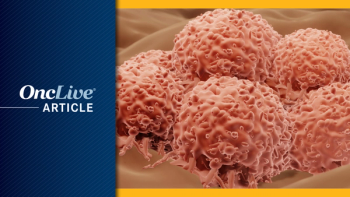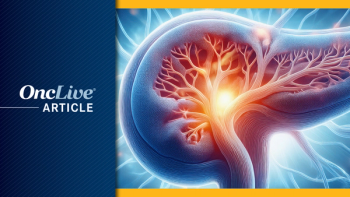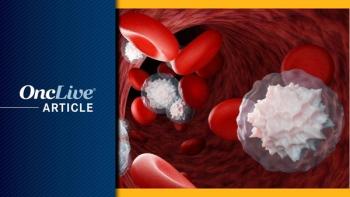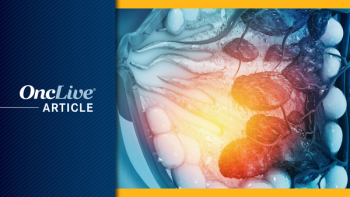
BMS-986158–Based Combos May Provide Another Viable Treatment Approach in Myelofibrosis
Haifa Kathrin Al-Ali, MD, provides background on the phase 1/2 study of BMS-986158, presents initial efficacy and safety data from the study, and discusses her hope that novel combination regimens like these could achieve the challenging goal of disease modification in myelofibrosis in the future.
The investigational, oral BET inhibitor BMS-986158 administered with either first-line ruxolitinib (Rituxan) or second-line fedratinib (Inrebic) showcased early efficacy and tolerability in patients with intermediate- or high-risk myelofibrosis. These data suggest that strategies combining BET and JAK inhibition can not only address myelofibrosis-related symptoms but may show potential for disease modification, according to Haifa Kathrin Al-Ali, MD.
Early efficacy data demonstrated that first-line BMS-986158 plus ruxolitinib led to spleen volume reduction (SVR) that became particularly robust by week 24. By week 48, 80% of patients (95% CI, 28%-100%) given the first-line ruxolitinib combination (n = 5) and 50% of those given the second-line fedratinib regimen experienced an SVR of at least 35%. In the ruxolitinib arm, the mean spleen volume change was –46.7% at week 12, –59.9% at week 24, and –56.3% at week 48; in the fedratinib arm, these percentages were –29.1%, -30.8%, and -33.0%, respectively.
“There is still a way to go, but these preliminary data are quite encouraging,” said Al-Ali, a professor of Translational Oncology and head of the Krukenberg Cancer Center at the University Hospital of Halle (Saale) in Germany.
In an interview with OncLive®, Al-Ali provided background on the phase 1/2 study of BMS-986158, presented initial efficacy and safety data from the study, and discussed her hope that novel combination regimens like these could achieve the challenging goal of disease modification in myelofibrosis in the future.
OncLive: What was the rationale for investigating the use of BET inhibitors as monotherapy or in combination with JAK inhibitors in myelofibrosis?
Al-Ali: We know that in patients [with myelofibrosis] there is a NF-κB–mediated pro-inflammatory cytokine profile. [This] leads to a dysregulated bone marrow microenvironment and osteoblastic differentiation, which contributes to the bone marrow fibrosis. It’s rational to use BET inhibitors because they have been shown to reduce or inhibit the expression of BET-targeted oncogenes like c-MYC and MYC.
Please describe the design of this study. Which patients were included this analysis, and what were the key objectives of the research?
This is an open-label, phase 1b/2 study. It mainly included patients with myelofibrosis who had splenomegaly and [had] either intermediate-1 [disease] plus symptoms, intermediate-2 [disease], or high-risk [disease, according to the Dynamic International Prognostic Scoring System]. The trial consisted of a dose-escalation phase followed by a dose-expansion phase. In the dose-escalation phase, there were also 2 parts. Part 1A [involved] first-line treatment with the BET inhibitor plus ruxolitinib in patients who had no previous exposure to ruxolitinib. [Part 1B consisted of] the second-line combination, [where] the BET inhibitor was combined with 400 mg of fedratinib and [was administered] once daily [to] patients with either intolerance or resistance to ruxolitinib.
This was a phase 1 study. [At the 2023 EHA Congress,] we presented the data from the dose-escalation phase, so the primary objective is always safety. The secondary objective was efficacy in terms of SVR. There were some exploratory analyses on JAK2 allele burden as well as bone marrow fibrosis.
According to data presented at the congress, what should be known about the safety of BMS-986158?
Regarding safety, [we] found that both the first-line combination with ruxolitinib or the second-line combination with fedratinib were feasible, tolerable, and the safety profiles were manageable. The main AE was thrombocytopenia, which is a class effect; it’s manageable and transient with dose modification or dose holding. The second major AEs were gastrointestinal [toxicities, including] diarrhea and nausea. Generally, these [effects] were mild, never led to the discontinuation of patients from the trial and were quite manageable.
What were the efficacy findings reported with these combinations?
Regarding efficacy, there are very promising results [showing] SVR of at least 35% from baseline by MRI. In the first-line cohort, there was a rapid and relevant reduction from baseline spleen volume [of at least 35%] in [73%] of patients [at week 12]. This seemed to be sustainable. Looking at SVR at week 24, 100% of patients [experienced] SVR. This is a phase 1 [study], and we should be careful, but these are encouraging results.
[Similar results were seen] with the second-line treatment, although the [duration of] follow-up was shorter. At week 12, at least [38%] of the patients [experienced] more than a 35% reduction in spleen volume. These are also encouraging results.
Finally, evidence for disease modification might be seen regarding JAK2 allele burden reduction. [This was] seen quite early, starting by cycle 6 in all the patients [with] JAK2-mutated [disease]. Additionally, in patients with follow-up bone marrow biopsies that could be evaluated, there seems to be a significant reduction in at least 1 grade of fibrosis by week 12 or week 24. [The study includes a] small number of patients, and these are preliminary, encouraging data. This bone marrow fibrosis regression seems to be associated with a hematological, [specifically] anemic, response.
You mentioned that potential evidence for disease modification may have been observed with this in the form of JAK2 allele burden reduction. In myelofibrosis, what efforts are currently underway to develop disease-modifying therapies that go beyond standard approaches focused on symptom management?
One of the major challenges [in myelofibrosis] is to see [clear evidence of successful] disease modification. All the biomarkers you can measure, like bone marrow fibrosis or a reduction in allele mutational burden, should have a clinical outcome correlation. This is a big challenge.
In the future, it is crucial to move away from only SVR and symptom improvement. We have great drugs that could do that. We have to wait for data from phase 3 randomized trials, and we need time to learn and [understand] the benefit of these combination treatments. My wish is to [achieve] sustainable, durable, clinical responses for patients with these combinations, but this is still an area with a lot of unanswered questions.
Are any next steps planned for the investigation of BMS-986158 in this disease?
The next step [for this research] is going further with the trial. The expansion phase has started for the first-line combination treatment in patients who are ruxolitinib naïve. The same will hopefully be happening for the second-line treatment. If these all [show] positive signals, we will move to a phase 3 clinical trial.
What is your main takeaway message for colleagues regarding this presentation?
The takeaway message is that it is feasible to have these combinations. We have learned how to dose [them] and how to manage AEs, which is the first step [for] every treatment. We have [also] shown encouraging preliminary clinical data regarding SVR, [as well as] some encouraging translational aspects like reduction in JAK allele burden or improvement in bone marrow fibrosis.
Overall, what was most exciting about this year’s EHA Congress?
[This year’s EHA Congress has] been particularly exciting. It is almost [solely] a myeloproliferative neoplasm congress because [there are] so many new, exciting datasets [being presented]—not only for a myelofibrosis, but also for polycythemia vera and essential thrombocythemia. At the end of the day, the most important winners will be the patients.
Reference
Ayala R, Lopez N, Abulafia AS, et al. BMS-986158, a potent BET inhibitor, as monotherapy and in combination with ruxolitinib or fedratinib in intermediate- or high-risk myelofibrosis (MF): results from a phase 1/2 study. Presented at the 2023 EHA Congress; June 8-11, 2023; Frankfurt, Germany. Abstract S213.

























































































